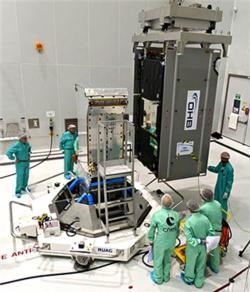Sun, Aug 17, 2014
Two Navigation Satellites To Be Delivered To Orbit August 21
The first of two Galileo navigation satellites to be orbited on Arianespace’s August 21 Soyuz flight has been integrated on its payload dispenser system, marking a key step as preparations advance for this medium-lift mission from French Guiana.

Named “Doresa,” the spacecraft was installed this month during activity inside the Spaceport’s S5A integration hall. It is to be joined on the dispenser system by the mission’s other passenger – “Milena,” whose own installation is forthcoming – in a side-by-side arrangement. The pair then will be mated atop Soyuz’ Fregat upper stage and encapsulated in the protective payload fairing.
“Doresa” and “Milena” – both built by OHB System – are the first FOC (Full Operational Capability) satellites for the Galileo constellation, which will create a European-operated space-based navigation system providing highly accurate, guaranteed global positioning services.
The FOC phase is being funded and executed by the European Union, with the European Space Agency designated as the Galileo system’s development and sourcing agent. The spacecraft payloads, which will generate precision positioning measurements and services to users worldwide, were supplied by Surrey Satellite Technology Ltd. in Guildford, UK.
Designated VS09 in Arianespace’s numbering system, the August 21 flight will be performed from the purpose-built ZLS launch facility for Soyuz – located in the Spaceport’s northern sector near the city of Sinnamary.
Next week’s mission continues Arianespace’s support in the overall Galileo system development. The company’s Starsem affiliate lofted two GIOVE (Galileo In-Orbit Validation Element) satellites in December 2005 and April 2008 on Soyuz missions conducted from Baikonur Cosmodrome in Kazakhstan.
These were followed by four Galileo satellites used for the system’s In-Orbit Validation (IOV) phase, launched in pairs on Soyuz flights performed by Arianespace from French Guiana in October 2011 and October 2012.
(Image provided by Arianespace)
More News
He Attempted To Restart The Engine Three Times. On The Third Restart Attempt, He Noticed That Flames Were Coming Out From The Right Wing Near The Fuel Cap Analysis: The pilot repor>[...]
Make Sure You NEVER Miss A New Story From Aero-News Network Do you ever feel like you never see posts from a certain person or page on Facebook or Instagram? Here’s how you c>[...]
From 2009 (YouTube Edition): Leading Air Show Performers Give Their Best Advice for Newcomers On December 6th through December 9th, the Paris Las Vegas Hotel hosted over 1,500 air >[...]
Aero Linx: NASA ASRS ASRS captures confidential reports, analyzes the resulting aviation safety data, and disseminates vital information to the aviation community. The ASRS is an i>[...]
“For our inaugural Pylon Racing Seminar in Roswell, we were thrilled to certify 60 pilots across our six closed-course pylon race classes. Not only did this year’s PRS >[...]
 NTSB Final Report: Rutan Long-EZ
NTSB Final Report: Rutan Long-EZ ANN FAQ: Turn On Post Notifications
ANN FAQ: Turn On Post Notifications Classic Aero-TV: ICAS Perspectives - Advice for New Air Show Performers
Classic Aero-TV: ICAS Perspectives - Advice for New Air Show Performers ANN's Daily Aero-Linx (06.28.25)
ANN's Daily Aero-Linx (06.28.25) Aero-News: Quote of the Day (06.28.25)
Aero-News: Quote of the Day (06.28.25)



